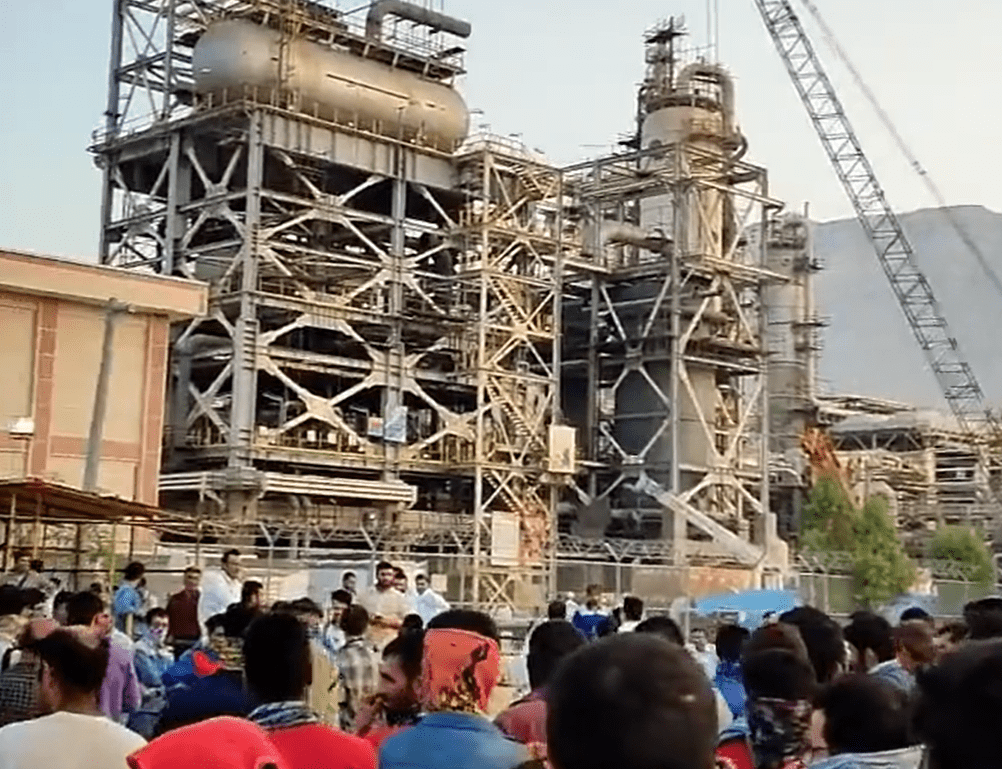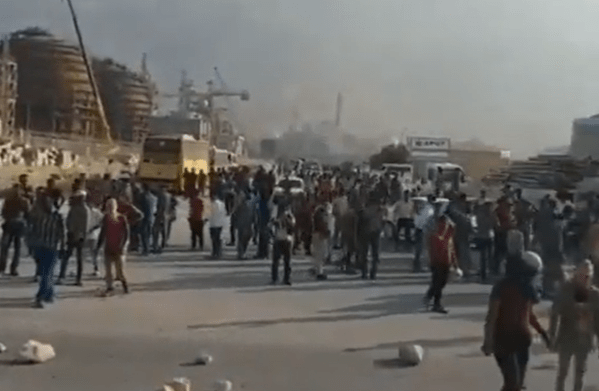By Ade Koudehi
As hundreds of thousands of Iranian women, students and schoolgirls burn their hijab scarves, “the flag of the ruling class”, the Islamic regime has now resorted to police raids on colleges and schools. It will stir up even more anger as other workers, students and youth follow the heroic example of Iranian women in fighting oppression.
In the face of police violence, attacks, arrests, rapes and murders, the wave of opposition has continued to reverberate around Iran. The death of the young Kurdish woman, Zhina Mahsa Amini, in custody, has sparked a wildfire of demonstrations, and rallies, in streets, workplaces and even in school yards. These are the signs of a growing revolutionary movement that threatens to overthrow the regime.
On Tuesday, Sept 13, Zhina was arrested by the ‘morality police’. She died on Saturday after four days in custody. The news of her going into a coma due to police brutality began to spread in all social media, and while the government denied their role in her death or somehow ‘normalizing’ police brutality – by saying that it also happens in other countries (like the case of George Floyd) – or that she had an underlying disease.
Scores of towns and cities hit by protests
There were demonstrations coinciding with her funeral, with students in universities in Tehran, Amirkabir, Isfahan, and other big cities, as there had been in 2009 against election vote-rigging and even in many small towns, also like in 2019 when there was a big jump in petroleum prices.
The website akhbar-rooz reported lists literally scores of towns and cities throughout Iran where there have been mass protests, including confrontations with state forces. Their report says that common slogans seen in the protests are “Death to the dictator“, “Death to Khamenei” and “We don’t want an Islamic Republic… we don’t want it“.
In many cities there are reports “…that people are standing up to the oppressive forces, pushing them back, blocking their lines of attack, and taking control of the streets”. Women and girls have “taken off their scarves and put them on fire. Police cars have been set on fire in several cities.” The website reports that police were shooting at demonstrators, in many cases, especially in the cities of Kurdistan, and many youth were killed.
Background of industrial unrest
The courageous protests of the young women is part of a wave of opposition movements. In the months leading to the current uprising many strikes took place. Last week a weekly teachers’ strike began, for wage increases in line with inflation. There have been strikes of petroleum welders over working conditions, mine workers over wage increases, and many others.
In response to the hijab protests of Iranian women, on Jul 11, groups of unofficial unions (which serve to protect workers’ rights against ‘official’ unions which do not) and other groups issued a general declaration against the mandatory wearing of the hijab. They wrote in part:
“…all the forces of the state [are used] to suppress protests against the high prices, poverty and the low wages of workers, medical staff, pensioners and teachers and protests against widespread unemployment, at a time when the public is more desperate than ever, the government decides to attack women and youth.“
Declaration by many labour organisations
This declaration was signed by 15 different groups, such as the independent formation of Progressive Students of the university of Isfahan, The Voice of Iranian Women, the Painters’ Syndicate of Alborz, but also, and importantly, by many groups of construction workers, painters, plumbers, electricians, homemakers, and pensioners’ groups, all from the relatively small city of Saghez in Kurdistan province. These groups were already organised in Saghez (her home town) before Zhina’s death, so when she was killed by the morality police in Tehran, there were many people and organisations ready to protest at the time of the funeral in her hometown.

The protest chant “Woman, Life, Liberty!” was first heard during the Kurdish woman’s liberation movement in 1987 on the streets of Istanbul. Then, in the 1990s, the ‘Monday Mothers’ sit-downs organized by Kurdish mothers demanding justice for their missing children being (often killed and their bodies never found) during the Turkish coup in 1980. Later, this slogan became the symbol of solidarity between Turkish and Kurdish feminists. Rojava’s militia even used it in the fight against ISIS in Syria.
Current situation – and explosive growth of opposition
All sectors and classes of Iranian society want revolution, except the ruling capitalist class. This class consists of Islamic Revolutionary Guards, a militia (Sepah) which owns many of the shares of big industries and businesses of the economy, especially in oil production. They also have investments in neighbouring countries to such an extent that they can assert a significant political influence, such as in Iraq, Syria, and Lebanon.
The relationship of this bureaucratic caste to the commercial capitalists (exporters of agricultural products to countries like Russia and Turkey and importers of consumer goods like phones, computers…) and middle class, like farmers and small traders, is shattered
This is for two reasons. Firstly, because the bureaucratic bourgeois has a dominant advantage over markets as they enjoy tax and tariff exemptions. Secondly, because of the imposition of sanctions by the West, in the absence of a new ‘nuclear deal’, is ruining businesses. As a result, even the majority of the capitalist class, except for the bureaucracy association with the mullahs and the Revolutionary Guards, wants to see regime change.
The forces of the current opposition movements come from the working class, students, unemployed, and women. There is also an impoverished middle class, dissatisfied with their economic condition and demanding political equality and democracy, but not necessarily the socialization of the means of production. Different opposition strands, therefore, are understood as being independent from each other.

All these different layers of society, however, are united in opposition towards the ruling class and the catalyst for the movement today is a feminist one. Why? Because the ideology of the ruling class is Islam, and women in their interpretation of Islam, are the second sex. In this sense, therefore, the liberty of all workers and the middle class depends on equality between the sexes.
On the ground, a mixture of ‘normality’ and opposition
In general, in the mornings, the business has been as usual. Daily activities take place almost everywhere. However, at night, the streets become the battlefields between the people and the forces of oppression. This time, the masses, especially the younger generation, have shown no fear. They were able to score victories, night after night, by pushing back the security forces.
They have adopted different tactics: burning trash bins to nullify tear gas, spreading gasoline on the street to take down security cars and motorbikes, trying to separate soldiers by running to a different direction and attacking those who are isolated, identifying and removing police infiltrating plain-clothes police, throwing rocks and Molotov cocktails, blockading highways and creating traffic to slowdown the mobilization police vehicles, drawing graffiti on walls and chanting from rooftops. Moreover, a number of hackers have managed to leak information from several government websites and briefly even managed to disrupt the national news channels that operate as the regime’s propaganda machinery.
Protests in Persian areas treated differently to minority regions
Across the country, the frequency and scale of the protests and nature of the suppression has varied. The regime has attacked the protests in the Persian province less violently than the province of other national groups. For instance, in Tehran and Isfahan, the police shot protesters with plastic bullets, but they used live bullets in Ahvaz, Zahedan, and in Kurdish areas. As many as fifty were killed on one Friday afternoon in Zahedan, the same number of people killed in the whole country during the first week.
In some cases, workers have been prepared to risk their lives at night in the streets but not necessarily to go on strike in their workplaces during the day. The only groups that have continued their struggles in the mornings are students and teachers. However, in Kurdistan and under the influence of the Kurdish Communist Party, daily strikes have been organised.
Labour organizations, students, women and other social layers have made a significant start by issuing a joint statement condemning the suppression of social freedoms. All of these different layers see themselves as partners and companions in women’s struggle against compulsory hijab and the right to equal rights.
There are many challenges that lie ahead, but the task today is to connect the different forms of struggle – the streets and campuses – to the strikes in the workplaces. The greater the unity there is and the clearer the political programme for fundamental social change, the greater the possibility of victory against this regime.



